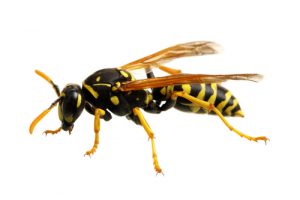Yellowjackets: Social wasps with very anti-social behavior!
By Chris Williams on June 21, 2011.
Q. I was mowing my lawn the other day when out of nowhere I’m getting stung by yellow jackets. They chased me all the way back into my house! How did they just show up like that?
A. Without a doubt, whenever the subject of yellow jackets comes up, there is probably not a person alive (with a few miles on them!) who doesn’t have a story of an unpleasant encounter with them. Once when I was a kid, I was looking for that perfect skimming stone at the edge of the causeway on a small pond in NH. One sting followed by another and then another before I could barely tell what was happening; I got out of there fast and they nearly chased me all the way back to the cottage where we (my family and I) were vacationing. It seems they were not amused by my getting too close to their nest somewhere down between the boulders where I was playing. A nature walk in the woods at the middle school in my hometown this past September (2010) ended in chaos with just one misstep.
Yellow jackets attack Dover, New Hampshire students during outside science lesson! Yes, yellow jackets will viciously defend their nest! So how did they just ‘show up’ like that? In actuality, that colony was started by a single founding queen during the early spring and has been steadily expanding for a few months. After she emerges from her overwintering quarters in early spring (I usually find them under fallen logs in the woods) she’ll seek out some type of cavity to settle down in to produce offspring. Rodent burrows, decaying stumps or landscape timbers, and wall voids in homes (especially attic eaves) make ideal nest sites for yellowjackets. The yellowjacket queen will fabricate a small nest for her first brood raising them entirely by herself. At the point where she has enough daughters to carry out foraging, nest building, rearing of young, and defense of the colony, then she’ll completely focus on producing more offspring. Depending upon the species, at their peak in late summer, yellowjacket colonies may contain from several hundred to several thousand workers plus reproductives of both sexes which will emerge to mate for the following years generation. In most climates, nests are abandoned during the fall, and only future queens survive the winter.
Here are some ‘fun facts’ about yellowjackets:
• Despite their nasty reputation, yellowjackets are very beneficial predators of many different pest species.
• Yellowjackets do not make honey, but instead are primarily ‘meat eaters’. During the late summer they will also feed upon decomposing orchard fruit and other sugary foods and are frequent ‘guests’ at late summer picnics.
• They release an alarm/aggression pheromone after stinging causing others to join the attack.
• Yellowjackets are in the wasp family Vespidae (contains all the social wasps) and are members of the genus Vespula.
• Yellowjackets primarily nest in underground cavities (rodent burrows) excavating soil to accommodate colony expansion, but they will often invade void spaces in homes and similar behavior may result in their breaking through walls and ceilings.
• There are two common sub-species of yellowjackets Dolichovespula maculata, and Dolichovespula arenaria that build aerial nests in shrubs, trees, and unfortunately below decks, eaves and porches.
